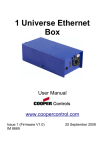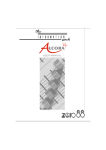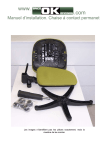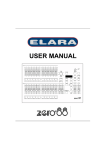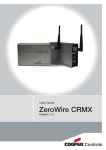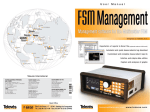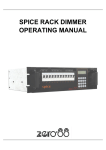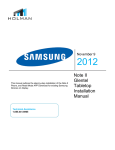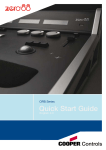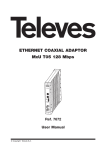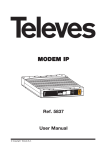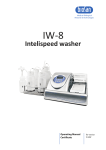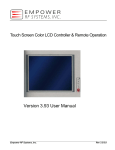Download MAN-069-0001 A - Permanet User Manual.pub
Transcript
1 Permanet User Manual Palmer Environmental Ltd Ty Coch House Llantarnam Park Way Cwmbran Permanet User Manual MAN-069-0001 Issue A Date 12/02/07 Written by SMK NP44 3AW United Kingdom Tel: +44 (0) 1633 489479 Fax: +44 (0) 1633 877857 Email: [email protected] Web: www.palmer.co.uk 2 Contents Contents Page 2 Warning Page 3 Introduction Page 4 Typical Systems Page 6 Extending the Range Page 7 RF Path Surveys and Spectrum Scans Page 8 Installation Notes Page 9 Permalog® Installation Page 10 Transmitter/Booster Installation Page 11 Concentrator Installation Page 13 Concentrator Antenna Installation Page 14 VHF SMS Concentrator Page 15 VHF SMS Concentrator LED Panel Page 16 VHF GPRS Concentrator Page 17 VHF GPRS Concentrator LED Panel Page 18 Conditions of Use Page 19 Contact Information Page 20 Permanet — Leakage Control Through Innovation 3 Warnings Permanet® Sensor and Magnet Warning: The Permanet® sensor can be seen from the bottom of the unit. Users must not attempt to unscrew this sensor as this may break internal components resulting in irreparable internal damage, sensor replacement is then the only option. Any necessary repair or dismantling of the sensor must be carried out by Palmer Environmental or by an authorised distributor. Important Safety Note: The Permanet® loggers use a high strength magnet and should not be carried by anyone with a heart pacemaker. This magnet can permanently corrupt magnetic storage media such as floppy discs, hard discs and tapes etc… It can also damage TV, PC monitor screens and some watches. Please ensure the logger is kept well clear of any such devices. Scope This manual covers the use of the Permanet® Permalog® loggers and the Permanet® software. Permanet — Leakage Control Through Innovation 4 Introduction Traditionally, following a rise in unaccounted for water the Permalog® leak noise loggers are deployed throughout the water network to provide continuous surveying of leakage. Each Permalog® logger adapts itself automatically to its environment. Using the Permalog® Patroller module, a patrol is normally carried out around the metered area. This module receives, analyses and “homes in” on signals to identify the units in LEAK mode and thereby the approximate position of the leaks. In an ideal world “patrolling” should be conducted on a daily basis. However, as patrolling is considered to be a labour intensive and time consuming activity by the majority of water companies it appears that patrolling is conducted on average, at best, on a monthly basis. Failing to patrol on a less than 24/7 basis can effectively defeat the object of deploying the Permalog's® as leaks can only be detected and made aware to the operator once a patrol has been carried out. In areas where it is not possible to actively patrol on a daily basis due to lack of resources or time, the Permanet® system is ideal as it removes the onus of having to physically patrol the area under investigation. Once put in place, the system actively monitors the network and reports daily on it’s findings thus omitting the need to conduct a manual patrol. Using transmitters talking to a central GSM/SMS VHF Wireless data hub, the Permalog's® send their leak status data to the central unit which in turn, sends an SMS text message to a central server. This data can then be analysed and the relevant action carried out depending on the reported status of each logger. Permanet — Leakage Control Through Innovation 5 The Permanet® transmitters, boosters and loggers represent the ultimate in low cost high performance reading devices for the leak detection market. Permalog Transmitter Key Features: • Encapsulated, IP68++ water proof design • Integral Robust Antenna • Reliable Operation Down to –25C • Built in 5 Year Battery Pack • Radio Silent Mode for Test and Transport • Moulded in Mounting Adapter for Simple Cable Tie Installation Permalog Logger Key Features: • GSM/SMS/GPRS Capability • Local Logging in Event of Radio Failure • GPRS Secure FTP Transfer • SMS on Change of State as Well as Daily De-Brief • UHF/VHF Capability • PSTN Option Available for Dialup Operation Transmission Options The transmitters are available with a number of transmission options: Walk-by/Drive-by—UHF Transmitters • Nominal 10 Second or 4 Second staggered transmission intervals Static System VHF Transmitters • With 15 Minute staggered update UHF/VHF Boosters • Wake every 6 hours, listen to UHF transmitters, re-transmit the data and go back into sleep mode Pre-Wired Transducer Options All transmitters are available pre-wired with co-axial cable and TNC connector to connect to a Permalog® transducer. Permanet — Leakage Control Through Innovation 6 Typical Systems There is no “specific” system one can recommend for use in all scenarios. Each site/ survey will require careful planning and execution. Typical systems can be seen below: System 1: Permalog® Transmitter to Receiver This could be a number of Permalog transmitters transmitting to a serial receiver. The serial receiver will output a string of data that the host interprets, converts, displays and stores. A typical system would comprise of:• Permalog® 153MHz—transmitting data every 15 minutes • Permalog® Serial Receiver 153MHz—receiver for the data System 2: Permalog® Transmitter to SMS Logger This could a number of Permalog® transmitters transmitting to a GSM logger. The logger validates the data, checks it against its database and creates or modifies the record. A Daily SMS (or multiple SMS) containing data for up to 6 Permalog's is sent. The SMS gateway receives and converts the data. A typical system would comprise of:• Permalog® 153MHz—transmitting data every 15 minutes • Permalog® GSM Logger 153MHz—data logger with daily SMS output • SMS Gateway—GSM modem that receives the data. Host has to interrogate the modem for the message received. System 3: Permalog® Transmitter to GPRS Gateway This could be a number of Permalog® transmitters transmitting to a GPRS logger. The logger validates the data and creates a file containing the information received. It then sends the file (via FTP) to a remote server via GPRS. The server receives and analyses the data. A typical system would comprise of:• Permalog® 153MHz—transmitting data every 15 minutes • Permalog® GPRS Logger 153MHz—data logger with periodic FTP to remote server • Data Server—receives files from GPRS concentrators which analyses and displays them • Data can be used with Radio-Tech’s Global-Net web application*. *Please contact us for further information on “Global-Net”. Permanet — Leakage Control Through Innovation 7 Extending the Range To extend the range of communications radio repeaters can be provided. Strategically placed, the repeaters can dramatically increase the range of the system communications. Another way to extent the range is to have the VHF transmitters above ground. We can provide a unique battery powered solution. The system comprises of a battery powered UHF transmitter transmitting data on a frequent basis, a UHF/VHF booster that is normally in sleep mode which then wakes every 6 hours to “listen and transmit” data from the UHF transmitter. The UHF transmitter can be mounted with the Permalog® (normally underground) and the booster can be placed at a suitable location above ground as shown below. Permanet — Leakage Control Through Innovation 8 RF Path Surveys and Spectrum Scans The only certain way of determining the suitability of a communication channel is to conduct a radio path survey and spectrum scan. The spectrum scan is something normally conducted prior to ordering a system to ensure the radio band is free from other users in the area. However, as by its nature the AMR system is a short ranged application, interference is extremely rare and the FM capture effect prevails (nearest signal wins). This, in most cases, cancels the need for a spectrum survey. If a confidence scan is required, both the desired and adjacent channels should be checked for signals. As transmissions may be intermittent it is important to take time with the scan, stopping for as long as possible on each channel and looking for at least 15 minutes on the final chosen band. If there is any doubt over the signal reaching the receiver a path survey should be conducted. Normally our AMR collectors, loggers and hand held devices will work satisfactory with a signal level below 100dBm. In free space this equates to a range of up to 300m. However, within the constraints of a building or a meter pit, this can vary from as little as 10m to 100m. The range ultimately depends on a combination of obstructions and the location of the transmitter with respect to metallic objects and ground level. Permanet — Leakage Control Through Innovation 9 Installation Notes Setting up effective and efficient practise is essential in order to get the best and consistent performance out of your Permanet® system. Each transmitter, untypical of general radio products and data loggers, has been engineered to withstand extremes of environment and climatic abuse. It can tolerate short-term to medium-term water submersion, operate at arctic temperatures as low as –45C and peak ambient temperatures reaching 80C. However, in order to maximise battery life we recommend an average operating temperature of below 60C. Hence, it is not advisable to mount the transmitter directly on the pipe without intervening insulation. The antenna of the transmitter is integrated within the narrow, tubular portion of the housing. For maximum transmission range the antenna should point upward (vertically polarised) and should be kept clear of obstructions, in particular metallic surfaces such as ducting and pipes. In practise if this is not practical, the unit can be mounted horizontally with only a small loss of transmission. Mounting can be easily achieved using a U-bracket or a cable-tie in either the vertical or horizontal directions. Mounting on metallic pipes parallel to the antenna should be avoided if you are looking to achieve maximum distance. This in many cases may not be necessary as often the transmission range achieved is still more than adequate. Permanet — Leakage Control Through Innovation 10 Permalog® Installation Installation is quite simple and all that is required is to connect the transmitter to the Permalog® via the TNC connector. Please ensure the contact is dry and free of any debris and the rubber washer is fitted to make a water tight seal before hand tightening the connector. Reset the Permalog® by passing a magnet close to, and across, the communications window. (the red LED will flash every 5 seconds). If the LED does not flash, then pass the magnet across the window again and look at the window to verify. Attach the Permalog® to a metal pipe fitting using the magnet on the base. Always ensure that the contact point is free from dirt so that the magnet makes a good contact. The Permalog® should remain in an upright/vertical position when installed. The transmitter antenna should be fitted as close to the top of the ground as possible using a method that suits the installation (screw/tie-wrap). NOTE: Resetting the Permalog® erases the internal memory. Should the logger be moved from one location to another, it must be reset to remove historical data. This is the only way to reset the unit - it cannot be switched off even if a magnet is passed over it many times. Once reset, it will operate continuously for the life of the batteries. Any medium strength magnet will reset the Permalog®; for convenience, the magnet on another Permalog may be used. Do not attempt to remove the magnet from the bottom of any Permalog® - it is securely fitted and calibrated and should not be removed. Permalog® units have no user serviceable parts. If any unit does not appear to function correctly then it must be returned to Palmer Environmental or an authorised Palmer representative. Both the UHF and VHF transmitters use the TNC connector to connect with the Permalog®, the only installation difference between them both is the VHF transmitter has a slightly larger enclosure. Permanet — Leakage Control Through Innovation 11 Transmitter/Booster Installation The repeaters (boosters) should be installed wherever there is a radio black spot or if you have trouble getting a signal from the Permalog® due to metallic/building/ electrical obstruction. Depending on the situation, they are normally located directly above (out of reach) or around the surrounding area of the Permalog’s location. Attachment to lamp-posts/masts can be made with u-brackets or tie-wraps. The unit is lightweight and can withstand extreme temperatures/water/dust. Repeaters do not require any connections. It is a self contained device that starts operating on manufacture. On all versions the unit incorporates a hidden transmitter enable/disable switch (reed switch). This switch is operated by a magnet to turn the transmitter on and off for transmit and service etc… To switch the transmitter on, hold a magnet on the side of the unit for approximately 2 seconds. For security reasons the location of the reed switch is not marked on the case itself and verification of operation is made by carefully listening for a faint click whenever the magnet is in close proximity to the reed switch. VHF Transmitter On the VHF transmitter, a tone can be heard using an RF scanner set to the frequency of operation. When the reed switch is first closed on the transmitters, they try to read the Permalog®. When the Permalog® data is detected, the transmitters get activated and start transmitting data. The address of the transmitter is defined by the Permalog data itself. This allows transmitters to be moved between Permalog's or replaced when required. The transmitters (once the Permalog® has been read successfully) toggle between transmitting tone and data packets. This is repeated for approximately 40 cycles which is approximately 3 minutes. This tone is a vital tool to test the installation. Permanet — Leakage Control Through Innovation 12 UHF Transmitter/UHF VHF-Booster As with the VHF transmitter, when the reed switch is first closed on the transmitters, they try to read the Permalog®. Up on detection, the transmitters become active and start transmitting data. The UHF/VHF boosters transmit a RF tone when the magnet is first placed and wake for approximately 3 minutes. During this period the boosters will listen for any UHF transmitters and re-transmit the data packet. The address is stored in memory and not re-transmitted during this “wake” period. The table below summarises the operation of the transmitters and boosters: UHF Transmitter Frequency MHz 869.850MHz VHF Transmitter UHF/VHF Booster 153.100 Receive: 869.850 169.40625 Transmit: 153.100 173.250 Transmit: 169.40625 Transmit: 173.250 Power mW <10 Permalog Sampling Period 2 hours Re-Transmission Time 10 seconds typical Battery Life 5 years TestMode Place magnet for 2 seconds. Permalog will be read and start transmitting data Permanet — Leakage Control Through Innovation <250 typical <250 typical 2 hours N/A 15 minutes typical 6 hours wakes for 25 seconds every 6 hours 5 years 5 years Place magnet until tone heard. Permalog will be read. Tone and data packets sent for approx. 3 minutes (40 data packets) Place magnet until tone heard. Will wake receiver and re-transmit any UHF message heard. Will stay awake for approx. 3 minutes. 13 Concentrator Installation The concentrator housing may be fitted with the supplied U-Bracket or heavy duty tiewraps via the pre-drilled holes (marked below in RED). It is ideal that the housing be placed in a secure position out of reach. The housing is securely mounted to the holding bracket via the pre-drilled holes located in the corners, as shown below in GREEN. The holding bracket is then fitted to a mast/wall via U-Brackets or Tie-Wraps. We do not recommend the housing be drilled internally as this will allow water ingress which could damage the internal electronics, only use the pre-drilled holes located in the 4 corners of the housing. Once the housing has been fixed in a safe and secure position, connect the antennas. The power supply must be connected to 240V mains. The unit is now ready for initialisation and operation. Permanet — Leakage Control Through Innovation 14 Concentrator Antenna Installation The concentrator antenna should be situated as high as possible in order for it to get the best possible range. Typically this is the highest peak on a mast pole. Secure the heavy duty mounting brackets to the mast pole using the supplied UBrackets. These must be placed 0.5 meters apart. Secure the mounting pole to the mounting brackets using the supplied U-Brackets. The concentrator antenna is then fitted to the top of the mounting pole, remembering to feed the cable down through the mounting pole prior to fastening it using the UBrackets. Once in place tie-wrap the antenna cable securely in place leading to the concentrator housing. Connection is made via the connector on the underside of the concentrator housing. Permanet — Leakage Control Through Innovation 15 VHF SMS Concentrator The SMS Concentrator is supplied complete ready for installation. After connecting the antennas, plug the logger into a power supply and it automatically begins the initialisation. After approximately 3 minutes, it sends itself a SMS message which it uses to synchronise it’s real time clock. After approximately 6 minutes, when it decodes the SMS message, 3 beeps should be heard which is an indication the unit is ready for operation. It will then send a scheduled SMS message at a pre-programmed time reporting data for all Permalog's it has registered. In addition, when it detects a “change of state” it will send an immediate SMS. The SMS messages will be sent to a pre-programmed number. The SMS server will receive and de-cipher the message and extract the Permalog information. The VHF SMS Concentrator can be seen below: Permanet — Leakage Control Through Innovation 16 VHF SMS Concentrator LED Panel There are 5 LED’s on the front panel of the unit. Mains Power Always ON indicating mains power is present Flashes on Power-up Continuous Flashes if mains fail and operating on battery power (for battery backed concentrators) Comms Present Flashes when GSM Engine is reset Solid when GSM engine is initialised Network Card Normally ON Receiving/Making Call Flashes when GSM engine is connected to send SMS or when receiving GSM call Connected/Data Valid Flashes when SMS is sent or when connection is made Permanet — Leakage Control Through Innovation 17 VHF GPRS Concentrator The GPRS logger is supplied complete ready for installation. After connecting the antennas, plug the logger into a power supply and it automatically begins the initialisation. After a few minutes of self tests, the unit will operate on a fixed strategy receiving and logging all the messages into a file. Periodically it will make a connection with a remote server and transfer the data. The VHF GPRS Concentrator can be seen below: Permanet — Leakage Control Through Innovation 18 VHF GPRS Concentrator LED Panel There are 5 LED’s on the front panel of the unit. Mains Power Always ON indicating mains power is present Flashes on Power-up Continuous Flashes if mains fail and operating on battery power (for battery backed concentrators) Comms Present Flashes when GSM Engine is reset Flashes as heart beat when operating normally (2 quick flashes then delay) Network Card Normally ON Receiving/Making Call ON when GPRS connection is made. OFF when there is no connection. Flashes if no GPRS connection and data being received from controller Connected/Data Valid Flashes when RF message is detected Permanet — Leakage Control Through Innovation 19 Conditions of Use Deployment of Permalog® units and Permanet® systems should be carried out in accordance with local regulations. Mishandling the logger could result in damage to the antenna (if incorrectly used to lower or raise the logger) or the sensor (connecting the logger to, or removing it from, the fitting). Such damage is not covered by Palmer Environmental’s warranty and customers are warned that damage to the sensor in particular is unlikely to be economic to repair. During handling and transportation of Permalog® units from site to site, care must be taken not to bring the communications window into the magnetic field of a medium or strong strength magnet. Continuous exposure to a magnetic field can result in variation in the Permalog’s® internal clock, which will lead to an increased possibility of false alarms. Particular care must be taken to avoid packing Permalog® units head to tail. Remedial work by Palmer Environmental required to correct loggers that have been affected in this way is not covered by warranty and will be charged. The magnet keeper fitted to Permalog® loggers should be left attached to the magnet until the unit is ready to be placed in its logging position. If the unit is to be moved for any reason the keeper should be refitted to the magnet. All Permalog® units should be transported with the keeper attached to the magnet. Ensure you have sufficient keepers for the magnets and plastic spacers (or pieces of card) to put between the keepers and the logger magnets. Removing keepers from the logger magnets takes some effort. Using the supplied plastic spacers or by inserting a thin piece of card between the keeper and the magnet makes this job easier. Always grasp the main body of the logger when placing or retrieving logger from the pipe fitting. Do not pull the loggers by it’s aerial or lead as this can cause damage. Permalog® units have no user serviceable parts. The enclosure protects the user from electrical shocks and other hazards. Servicing must be referred to competent personnel. If any unit does not appear to function correctly then it must be returned to Palmer Environmental or an authorised Palmer representative. Permanet — Leakage Control Through Innovation 20 Contact Palmer Environmental Ltd Ty Coch House Llantarnam Park Way Cwmbran Gwent NP44 3AW United Kingdom Tel: +44 (0) 1633 489479 Fax: +44 (0) 1633 877857 General Enquires: [email protected] Technical support: [email protected] Web: http://www.palmer.co.uk Note Palmer Environmental reserves the right to change products, services or specifications without notice. Patents The Permalog® system is patented in the United Kingdom GB2335041, GB2361062, GB2361319, GB2361540 & GB2361541. Patents pending in Europe, United States and Japan. Permalog® and Permanet® is a Registered Trademark of Palmer Environmental. Permanet User Manual MAN-069-0001 Issue A Date 12/02/07 Written by SMK




















